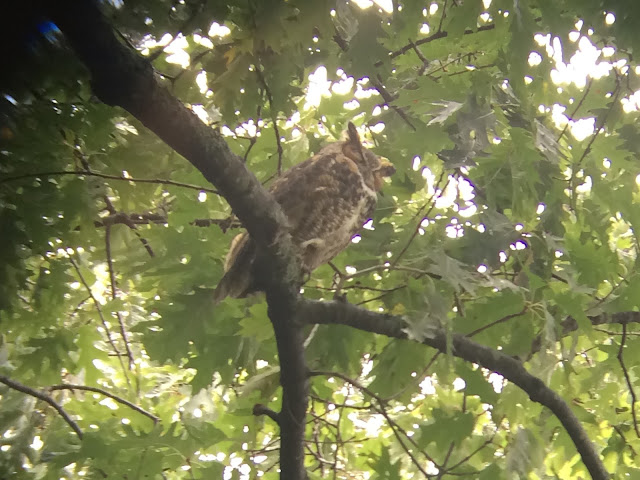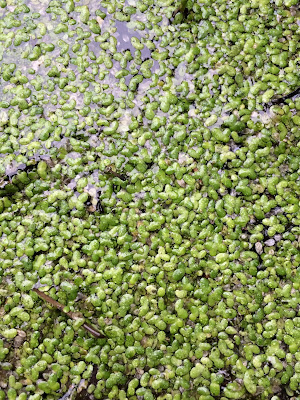Transect at Site Alpha
Time: 1:16 to 1:26 PM
Weather: 46 degrees Fahrenheit, sunny, 10mph wind
Location: Lesley University Brattle Campus - Cambridge, MA
Point A:
-Crushed acorns/acorn caps
-Dried oak, maple, and other leaves covering the ground
-Fallen twigs and small branches
Point B:
-Small weed that has gone to seed
-Ant running along measuring tape
-Dried leaves
-Grass still green and seemingly healthy
Point C:
-Dried leaves are more abundant
-More medium or small black ants
Point D:
-Even more leaves, but mostly from a nearby maple
-Some litter
Point E:
-Lots of crushed acorns in the dirt
-Sugar ants
-Fewer fallen leaves, but the ones present look older
Changes in Site Alpha:
The most noticeable change from my original transect on September 16th was the large number of leaves covering the ground. There were dried leaves even then, but not enough to mostly obscure my view of the grass. At the time a tree that I referred to as "Tree 1" still had most of its leaves and was only yellowing slightly, but the tree was completely naked when I visited on October 26th. Another noticeable change was in temperature. Site Alpha was 64 degrees Fahrenheit on October third (the first time I measured temperature), and on October 26th it was 46 degrees. It appeared that there were more fallen and broken up acorns, as well. I did not encounter evidence of arthropods as frequently as I did in September, such as crickets/other insect calls, many ants, a jumping spider, and a gnat. I imagine that the many broken up acorns are a result of being stepped on or mowed over by people, but other than that I cannot think of other human interference. It is clear that summer is long gone and the trees and animals are preparing for cooler days. Many of the insects have likely migrated or are in diapause, and most of the trees in the area have changed color or completely dropped their leaves.
What Remained the Same:
There is still a scarcity of grass in Site Alpha, and the canopy of the oak remains largely unchanged by the cooler weather. In the photo above you can see that it still has a green canopy, whereas the maple nearby is a brilliant yellow-orange. Ants were still milling around, but only small black sugar ants. The area was still pebbly and covered with small acorns.
Transect at Site BetaDate: October 26th, 2016
Time: 1:40 to 1:50 PM
Weather: 46 degrees Fahrenheit, chilly in the shade, 10mph wind
Location: Lesley University Brattle Campus - Cambridge, MA
Point A:
-Some fallen oak leaves, but not many
-Can feel many acorns underfoot
-Majority of acorns are crushed by mowers
-Two squirrels spotted
Point B:
-Fewer fallen leaves
-Fallen branch with leaves still attached
-Unshelled acorn with chew marks
Point C:
-Not many acorns visible
-Numerous holes that I believe are the result of squirrels burying their finds
-Grass is longer as I approach the large oak tree - Perhaps it is difficult to mow over the roots?
Point D:
-Large fungus is still attached to the tree, but looks a little dry and there are acorns embedded into its surface
-A surprising number of young dandelion plants
-More chewed acorns
Point E:
-Less grass near tree trunk, and some of it is dead
-Acorn fragments scattered about
-Not many fallen leaves
Transect at Site Gamma
Date: October 26th, 2016
Time: 1:29 to 1:38 PM
Weather: 46 degrees Fahrenheit, cold in shade/sun behind the clouds, 10mph wind
Location: Lesley University Brattle Campus - Cambridge, MA
Point A:
-Squirrels in nearby trees and digging through fallen leaves
-Rough moss that is not a rich green, but a dark green/brown
-Beech seeds and burst open shells
-Flowering weed
-Tons of honeylocust pods all over the surrounding area
-Honeylocust seeds are now dark brown instead of a greenish tan (possibly ripe now)
Point B:
-Dried oak leaves and tons of honeylocust pods
-Shards of glass in the dirt
-One of the chestnuts I left last time was missing one side of its shell and there were nibble marks on the flesh of the nut
-Low growing dandelion greens
-A thick carpet of yellow honeylocust leaves was on the ground
Point C:
-A fragment of terra-cotta about the size of a cell phone
-My "offering site" is mostly empty and some of the honeylocust seeds I left last time have begun to sprout! You can even see a small snail to the right of one of the sprouted seeds
-The site has scratch marks and small holes in it, as if the squirrels were digging around
Point D:
-More glass shards in the dirt
-Fewer fallen leaves
-Cigarette butt with lipstick stain
Point E:
-Lots of oak and other old, dried leaves
-Some honeylocust pods, but not as many as near the start of the transect
-Beech canopy has retained most of its leaves
-Tree leaves changing color or dropping to the ground
-Abundant nuts and seeds, especially acorns
-The presence of a tree at each site
-Presence of lawn grass
-Squirrel activity
Key Differences:
-Site Alpha and Beta are occupied by large oak trees, while Site Gamma has honeylocust trees and a beech
-Site Gamma is in an are less frequented by the students living on the dorm
-Site Beta is the only site with large fungal growths
I do not think that I have data that is specific enough for a chart or table, especially since it was not consistently recorded. I made sure that all three transects were very close to each other, so they do not have drastic differences. All three are also on school property, so the terrain does not have much variation or a chance to grow wild due to mowing. I can't seem to glean much from the differences, but the similarities point to the approach of winter.
Time: 1:29 to 1:38 PM
Weather: 46 degrees Fahrenheit, cold in shade/sun behind the clouds, 10mph wind
Location: Lesley University Brattle Campus - Cambridge, MA
Point A:
-Squirrels in nearby trees and digging through fallen leaves
-Rough moss that is not a rich green, but a dark green/brown
-Beech seeds and burst open shells
-Flowering weed
-Tons of honeylocust pods all over the surrounding area
-Honeylocust seeds are now dark brown instead of a greenish tan (possibly ripe now)
Point B:
-Dried oak leaves and tons of honeylocust pods
-Shards of glass in the dirt
-One of the chestnuts I left last time was missing one side of its shell and there were nibble marks on the flesh of the nut
-Low growing dandelion greens
-A thick carpet of yellow honeylocust leaves was on the ground
Point C:
-A fragment of terra-cotta about the size of a cell phone
-My "offering site" is mostly empty and some of the honeylocust seeds I left last time have begun to sprout! You can even see a small snail to the right of one of the sprouted seeds
-The site has scratch marks and small holes in it, as if the squirrels were digging around
Point D:
-More glass shards in the dirt
-Fewer fallen leaves
-Cigarette butt with lipstick stain
Point E:
-Lots of oak and other old, dried leaves
-Some honeylocust pods, but not as many as near the start of the transect
-Beech canopy has retained most of its leaves
Comparing all Three Transects
Key Similarities:-Tree leaves changing color or dropping to the ground
-Abundant nuts and seeds, especially acorns
-The presence of a tree at each site
-Presence of lawn grass
-Squirrel activity
Key Differences:
-Site Alpha and Beta are occupied by large oak trees, while Site Gamma has honeylocust trees and a beech
-Site Gamma is in an are less frequented by the students living on the dorm
-Site Beta is the only site with large fungal growths
I do not think that I have data that is specific enough for a chart or table, especially since it was not consistently recorded. I made sure that all three transects were very close to each other, so they do not have drastic differences. All three are also on school property, so the terrain does not have much variation or a chance to grow wild due to mowing. I can't seem to glean much from the differences, but the similarities point to the approach of winter.



















































